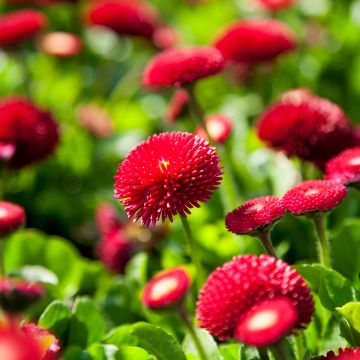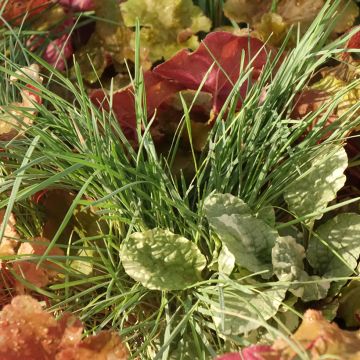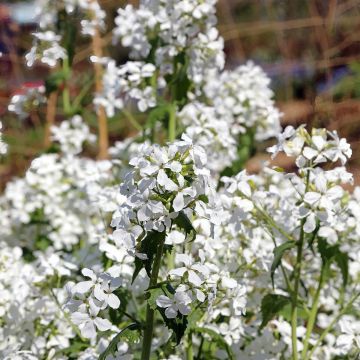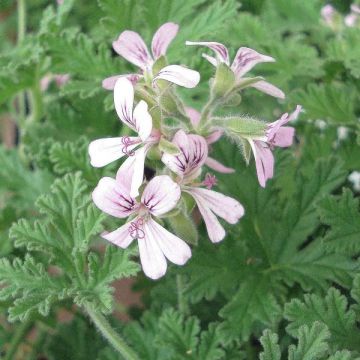

Arabis caucasica Roselite Mini-mound
Arabis caucasica Roselite Mini-mound
Arabis caucasica Roselite
Mountain Rock Cress, Alpine Rock Cress, Alpine Rockcress, Caucasus Rockcress, Wall Rock Cress
Hasn't shooted! Very disappointed!
MONIQUE S., 03/05/2017
Special offer!
Receive a €20 voucher for any order over €90 (excluding delivery costs, credit notes, and plastic-free options)!
1- Add your favorite plants to your cart.
2- Once you have reached €90, confirm your order (you can even choose the delivery date!).
3- As soon as your order is shipped, you will receive an email containing your voucher code, valid for 3 months (90 days).
Your voucher is unique and can only be used once, for any order with a minimum value of €20, excluding delivery costs.
Can be combined with other current offers, non-divisible and non-refundable.
Why not try an alternative variety in stock?
View all →This plant carries a 6 months recovery warranty
More information
We guarantee the quality of our plants for a full growing cycle, and will replace at our expense any plant that fails to recover under normal climatic and planting conditions.
Would this plant suit my garden?
Set up your Plantfit profile →
Description
Arabis caucasica 'Roselite' is a perennial full of charm for pots, containers and borders. From March, a carpet of deep pink flowers to be harmonised with biennials, bulbs and other early perennials.
The 'Roselite' Caucasian rock-cress (Arabis alpina subsp. caucasica) is the sister variety of the Arabis caucasica 'Alabaster' (white). Like the latter, it is a new sterile hybrid from Germany with large flowers and a very long flowering period. Its intense carmine purple colour will add depth to a colour combination in harmony of pink tones, for example with tulips, pansies, tiarellas... or even the lilac-pink foliage of the 'Berry Smoothie' heuchera. It also pairs well with the blue of forget-me-nots or of course white... Thanks to its spreading growth, 'Roselite' is perfect for decorating the edge of a pot on a terrace or a container. No matter how it is associated, it is always easy to grow and fast-growing, in short, it is a plant that can always be relied upon!
Planted in autumn, the 'Roselite' Caucasian rock-cress will develop during winter a carpet of evergreen foliage, with an oval shape and a serrated border, in a green colour tending toward grey. At the very beginning of spring, from March, numerous dark pink 4-petalled flowers tending toward purple will succeed each other without interruption until May. If it has been planted in a pot with biennials, then this will be time to replant it in the garden to enjoy it again the following year! The 'Roselite' rock-cress thrives in all types of soil as long as it has a full sun location. Perfectly hardy, it will adapt very well in a rock garden or along a border. It can also make a very good ground cover of about 20 cm (7.9 in) in height.
Note: Attention, our young plants in mini pots are professional products reserved for experienced gardeners: upon receipt, transplant them as soon as possible, in pots, containers or directly in borders.
Report an error about the product description
Flowering
Foliage
Plant habit
Botanical data
Arabis
caucasica
Roselite
Brassicaceae
Mountain Rock Cress, Alpine Rock Cress, Alpine Rockcress, Caucasus Rockcress, Wall Rock Cress
Cultivar or hybrid
Other Biennials A to Z
View all →Planting and care
The 'Alabaster' Caucasian Rockcress mini-plants can be planted in pots and containers or directly in the ground in a finely prepared and enriched soil. Plant them if possible upon receipt, in September-October. If the planned location is not yet ready or if the conditions are not favourable for planting (heavy rains or excessively dry soil), you can let them grow in pots for 4 to 6 weeks. After planting, you can lightly pinch the tip of the plant between your thumb and index finger to remove the terminal bud and stimulate branching (optional). In pots and containers, use a good well-draining soil mix for flowering plants (for example, with a lot of bark or perlite) and enriched with slow-release fertiliser. The top of the root ball should be level with the soil. Water generously at planting and during the following weeks, as the mini-plants can dry out quickly. However, be careful not to overwater! Make sure to use containers with drainage holes and to empty the saucer 10 minutes after watering. Remember to water even during winter if it doesn't rain or if the container is placed in a sheltered location away from precipitation. Do not water during freezing periods. Once growth resumes, in late February or early March, and throughout the flowering period, apply a liquid fertiliser for flowering plants 1 to 2 times per week diluted in the watering can. Once flowering is finished, the plants in pots can be replanted in the garden in full sun.
Planting period
Intended location
Care
-
, onOrder confirmed
Reply from on Promesse de fleurs
Similar products
Haven't found what you were looking for?
Hardiness is the lowest winter temperature a plant can endure without suffering serious damage or even dying. However, hardiness is affected by location (a sheltered area, such as a patio), protection (winter cover) and soil type (hardiness is improved by well-drained soil).

Photo Sharing Terms & Conditions
In order to encourage gardeners to interact and share their experiences, Promesse de fleurs offers various media enabling content to be uploaded onto its Site - in particular via the ‘Photo sharing’ module.
The User agrees to refrain from:
- Posting any content that is illegal, prejudicial, insulting, racist, inciteful to hatred, revisionist, contrary to public decency, that infringes on privacy or on the privacy rights of third parties, in particular the publicity rights of persons and goods, intellectual property rights, or the right to privacy.
- Submitting content on behalf of a third party;
- Impersonate the identity of a third party and/or publish any personal information about a third party;
In general, the User undertakes to refrain from any unethical behaviour.
All Content (in particular text, comments, files, images, photos, videos, creative works, etc.), which may be subject to property or intellectual property rights, image or other private rights, shall remain the property of the User, subject to the limited rights granted by the terms of the licence granted by Promesse de fleurs as stated below. Users are at liberty to publish or not to publish such Content on the Site, notably via the ‘Photo Sharing’ facility, and accept that this Content shall be made public and freely accessible, notably on the Internet.
Users further acknowledge, undertake to have ,and guarantee that they hold all necessary rights and permissions to publish such material on the Site, in particular with regard to the legislation in force pertaining to any privacy, property, intellectual property, image, or contractual rights, or rights of any other nature. By publishing such Content on the Site, Users acknowledge accepting full liability as publishers of the Content within the meaning of the law, and grant Promesse de fleurs, free of charge, an inclusive, worldwide licence for the said Content for the entire duration of its publication, including all reproduction, representation, up/downloading, displaying, performing, transmission, and storage rights.
Users also grant permission for their name to be linked to the Content and accept that this link may not always be made available.
By engaging in posting material, Users consent to their Content becoming automatically accessible on the Internet, in particular on other sites and/or blogs and/or web pages of the Promesse de fleurs site, including in particular social pages and the Promesse de fleurs catalogue.
Users may secure the removal of entrusted content free of charge by issuing a simple request via our contact form.
The flowering period indicated on our website applies to countries and regions located in USDA zone 8 (France, the United Kingdom, Ireland, the Netherlands, etc.)
It will vary according to where you live:
- In zones 9 to 10 (Italy, Spain, Greece, etc.), flowering will occur about 2 to 4 weeks earlier.
- In zones 6 to 7 (Germany, Poland, Slovenia, and lower mountainous regions), flowering will be delayed by 2 to 3 weeks.
- In zone 5 (Central Europe, Scandinavia), blooming will be delayed by 3 to 5 weeks.
In temperate climates, pruning of spring-flowering shrubs (forsythia, spireas, etc.) should be done just after flowering.
Pruning of summer-flowering shrubs (Indian Lilac, Perovskia, etc.) can be done in winter or spring.
In cold regions as well as with frost-sensitive plants, avoid pruning too early when severe frosts may still occur.
The planting period indicated on our website applies to countries and regions located in USDA zone 8 (France, United Kingdom, Ireland, Netherlands).
It will vary according to where you live:
- In Mediterranean zones (Marseille, Madrid, Milan, etc.), autumn and winter are the best planting periods.
- In continental zones (Strasbourg, Munich, Vienna, etc.), delay planting by 2 to 3 weeks in spring and bring it forward by 2 to 4 weeks in autumn.
- In mountainous regions (the Alps, Pyrenees, Carpathians, etc.), it is best to plant in late spring (May-June) or late summer (August-September).
The harvesting period indicated on our website applies to countries and regions in USDA zone 8 (France, England, Ireland, the Netherlands).
In colder areas (Scandinavia, Poland, Austria...) fruit and vegetable harvests are likely to be delayed by 3-4 weeks.
In warmer areas (Italy, Spain, Greece, etc.), harvesting will probably take place earlier, depending on weather conditions.
The sowing periods indicated on our website apply to countries and regions within USDA Zone 8 (France, UK, Ireland, Netherlands).
In colder areas (Scandinavia, Poland, Austria...), delay any outdoor sowing by 3-4 weeks, or sow under glass.
In warmer climes (Italy, Spain, Greece, etc.), bring outdoor sowing forward by a few weeks.






















































